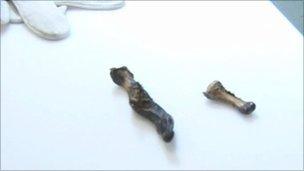Yeti finger mystery solved by Edinburgh scientists
- Published
Scientists from Edinburgh Zoo have solved the riddle of a yeti finger taken from a Nepalese monastery half a century ago
The mystery of a yeti finger taken from Nepal half a century ago has been solved with the help of scientists at Edinburgh Zoo.
The mummified remains have been held in the Royal College of Surgeons museum in London since the 1950s.
A DNA sample analysed by the zoo's genetic expert Dr Rob Ogden has finally revealed the finger's true origins.
Following DNA tests it has found to be human bone.
The yeti, also known as the Abominable Snowman, is a legendary giant ape-like creature said to inhabit the Himalayan region of Nepal and Tibet.
Despite the lack of evidence of its existence, the yeti myth retains a strong appeal in both Nepal and the west, where it became popular in the 19th century.
The finger, which was said to be from a yeti, was taken from a Nepalese monastery by an American explorer in the 1950s.
He replaced it with a human finger he had been given by a British scientist.

The yeti finger was taken from a Nepalese monastery by an American explorer in the 1950s
It was then smuggled out of India with the help of Hollywood actor James Stewart, who hid the artefact in his wife's lingerie case.
The finger is now held in the Royal College of Surgeons museum in London.
Just recently it was rediscovered during cataloguing.
They allowed a BBC documentary team to take a DNA sample.
It has been analysed by genetic experts at Edinburgh Zoo, who concluded it is human.
Dr Rob Ogden, of the Royal Zoological Society of Scotland, said: "We had to stitch it together. We had several fragments that we put into one big sequence and then we matched that against the database and we found human DNA.
"So it wasn't too surprising but it was obviously slightly disappointing that you hadn't discovered something brand new.
"Human was what we were expecting and human is what we got."
Primatologist Ian Redmond said: "From what we know of accounts of Yetis, I would have expected a more robust and longer finger and possibly with some hair on the back.
"If one had just found it without the story attached to it, I think you would think it was a human finger.
- Published27 December 2011